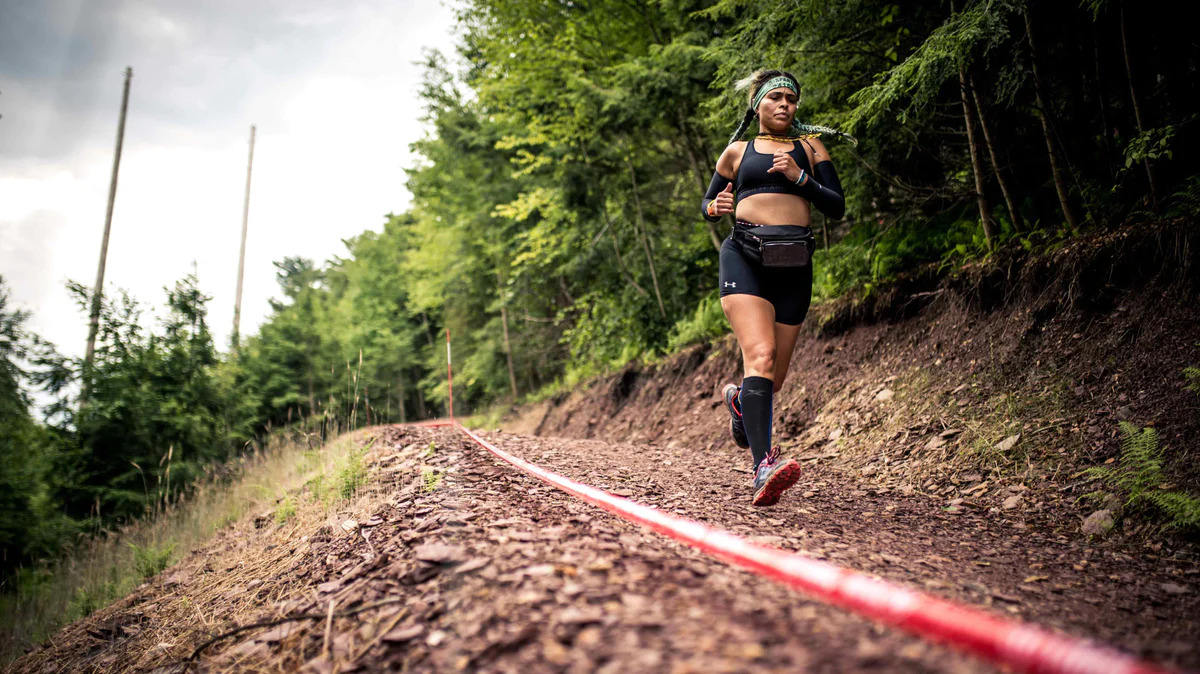

Featured
How To Increase Stamina For Hiking
Published: October 15, 2023
Discover the best tips and exercises to boost your stamina for hiking. Get featured techniques to increase endurance and conquer the trails.
Introduction
Embarking on a hiking adventure can be an exhilarating and rewarding experience. Whether you’re exploring breathtaking mountain trails or wandering through lush forests, hiking allows you to connect with nature and challenge yourself physically. However, to truly enjoy the journey, it’s essential to have the stamina to endure long hikes and tackle steep terrains.
Stamina, also known as endurance, is the ability of your body to sustain physical activity over an extended period. It plays a crucial role in hiking, as it determines how long you can hike without feeling fatigued or out of breath. Building stamina for hiking requires a combination of physical fitness, mental determination, and proper preparation.
In this article, we will explore various strategies to increase your stamina for hiking, ensuring that you can conquer challenging trails with confidence. From maintaining a regular exercise routine to incorporating strength training exercises, we will cover essential steps to prepare your body for the demands of hiking. Additionally, we will discuss the importance of monitoring your diet, staying hydrated, getting adequate rest, and using proper hiking gear and equipment. Lastly, we will delve into mental strategies to help you stay motivated and push through any physical or mental challenges you may encounter on the trail.
By following these tips and incorporating them into your hiking routine, you can gradually enhance your stamina, allowing you to enjoy longer hikes, explore new destinations, and make the most of your outdoor adventures.
Importance of Stamina for Hiking
Stamina is a vital component for any hiker, irrespective of their level of experience. Having sufficient stamina allows you to hike for longer durations and take on more challenging trails, ultimately enhancing your overall hiking experience. Here are a few reasons why stamina is crucial for hiking:
1. Endurance and Longevity: Hiking often involves traversing uneven terrains, steep inclines, and long distances. Without adequate stamina, you may find yourself quickly becoming fatigued and unable to continue. Building stamina ensures that you can sustain physical exertion for extended periods, enabling you to explore beautiful landscapes and enjoy the outdoors for longer durations.
2. Safety: Hiking in remote areas can present unpredictable challenges and unexpected obstacles. Having sufficient stamina allows you to navigate tricky paths and make sound decisions when faced with potential dangers. Moreover, being physically fit reduces the risk of injuries and accidents, making it easier to handle emergencies and ensure a safe hiking experience.
3. Enjoyment of the Scenery: Hiking often takes you to breathtaking natural landscapes, providing a unique opportunity to appreciate the beauty of nature. Building stamina enables you to hike at a comfortable pace, taking in the sights and sounds around you without feeling rushed or exhausted. With improved stamina, you can soak in the serenity of the environment and fully immerse yourself in the hiking experience.
4. Exploration of Challenging Trails: Many popular hiking trails feature rugged terrains and steep ascents, offering a sense of adventure and accomplishment to those who complete them. Strong stamina allows you to tackle these challenging trails with confidence and determination. It opens up a world of possibilities, allowing you to explore new destinations and push your limits as a hiker.
5. Overall Health and Well-being: Building stamina for hiking goes beyond the benefits it brings to your outdoor adventures. It also improves your overall health and well-being. Regular physical exercise, like hiking, contributes to cardiovascular fitness, weight management, improved muscle strength, and enhanced mental health. By increasing your stamina for hiking, you are investing in your long-term health and enjoying the numerous benefits of an active lifestyle.
These reasons emphasize the significance of building stamina for hiking. As you embark on this journey to increase your endurance, keep in mind the incredible rewards that await you. From extended hiking trips to breathtaking views, building stamina transforms hiking from a mere activity to an unforgettable adventure.
Preparing Your Body for Hiking
Preparing your body for hiking is essential to ensure that you can meet the physical demands of the trail and prevent injuries. Here are ten key steps to help you get your body ready for the challenges that lie ahead:
- Maintaining a Regular Exercise Routine: Consistency is key when it comes to building stamina. Engage in regular physical activity, such as walking, jogging, or cycling, to improve cardiovascular fitness and endurance. Aim for at least 30 minutes of moderate-intensity exercise on most days of the week.
- Building Endurance Through Cardiovascular Training: Focus on activities that elevate your heart rate and challenge your cardiovascular system. This could include brisk walking, hiking on inclines, using an elliptical machine, or swimming. Gradually increase the duration and intensity of your cardiovascular workouts to improve endurance.
- Incorporating Strength Training Exercises: Strengthening your muscles is crucial for hiking, especially when navigating steep inclines or carrying a backpack. Include exercises that target major muscle groups, such as squats, lunges, deadlifts, and shoulder presses. Aim for two to three strength training sessions per week.
- Increasing Flexibility and Stretching Exercises: Flexibility plays a vital role in preventing injuries, enhancing mobility, and maintaining good posture on the trail. Incorporate stretching exercises into your routine to improve flexibility in your hips, hamstrings, calves, and shoulders. Perform dynamic stretches before hiking and static stretches afterwards.
- Gradually Increasing Hiking Intensity and Duration: Start with shorter and less challenging hikes and gradually increase the intensity and duration over time. This progressive approach allows your body to adapt to the demands of hiking and reduce the risk of overuse injuries. Listen to your body and give yourself time to recover between hikes.
- Monitoring and Adjusting Your Diet: Fueling your body with nutritious foods is essential for building stamina. Prioritize a balanced diet that includes lean proteins, whole grains, fruits, vegetables, and healthy fats. Avoid processed foods and sugary snacks that can cause energy crashes. Consider consulting with a nutritionist for personalized guidance.
- Staying Hydrated: Dehydration can lead to fatigue, muscle cramps, and decreased performance. Carry an adequate supply of water and drink regularly during your hikes. Remember that hydration is a continuous process, so stay hydrated before, during, and after hiking. Electrolyte-rich beverages can also help replenish essential minerals lost through sweating.
- Getting Adequate Rest and Recovery: Rest is essential for allowing your body to repair and adapt to the physical stresses of hiking. Make sure to get enough sleep and listen to your body’s signals for rest days. Incorporate recovery activities like gentle stretching, yoga, or foam rolling to alleviate muscle soreness and promote faster recovery.
- Using Proper Hiking Gear and Equipment: Invest in high-quality hiking shoes or boots that provide adequate support, traction, and protection. Wear moisture-wicking and breathable clothing to stay comfortable during hikes. Use hiking poles to reduce stress on your knees and maintain balance on uneven terrain. Pack a well-fitted backpack that distributes weight evenly.
- Mental Strategies for Building Stamina: Building stamina for hiking extends beyond physical preparation. Train your mind to stay focused, motivated, and resilient during challenging hikes. Set achievable goals, practice positive self-talk, and break the hike into smaller milestones to keep yourself motivated. Embrace the beauty of nature and enjoy the journey rather than focusing solely on the destination.
By following these steps, you will gradually enhance your body’s endurance and strength, allowing you to tackle longer and more challenging hikes with confidence. Remember, preparing your body for hiking is a continuous process, and consistency is key to building and maintaining stamina for your outdoor adventures.
Maintaining a Regular Exercise Routine
Maintaining a regular exercise routine is the foundation for building stamina for hiking. Regular exercise helps improve cardiovascular fitness, increases endurance, and strengthens your muscles. By incorporating a consistent exercise regimen into your lifestyle, you will be better equipped to take on challenging hikes and enjoy longer durations on the trail.
When establishing a regular exercise routine, it’s important to choose activities that elevate your heart rate and challenge your cardiovascular system. Walking, jogging, cycling, swimming, or using cardio machines like the elliptical or stair climber are great options. Aim for at least 30 minutes of moderate-intensity exercise on most days of the week.
The key to maintaining a regular exercise routine is finding activities that you enjoy and that fit into your schedule. If you don’t enjoy traditional gym workouts, consider alternative forms of exercise such as dance classes, hiking on local trails, or joining a sports team. Engaging in activities that you find enjoyable will make it easier to stay motivated and stick to your routine.
Additionally, incorporating variety into your exercise routine can help prevent boredom and keep your body challenged. Try mixing up your workouts by alternating between different activities, such as swimming one day and going for a hike the next. This not only helps to prevent plateauing but also keeps your mind engaged and excited about exercise.
Remember to start slowly and gradually increase the intensity and duration of your workouts. If you’re new to exercise or have been inactive for a while, it’s important to build up your stamina gradually to avoid overexertion and potential injuries. This can be achieved by starting with shorter and less intense sessions and gradually increasing the duration and intensity over time.
Consistency is the key to maintaining a regular exercise routine. Find a schedule that works for you and make exercise a priority. Consider blocking off specific times in your calendar dedicated to physical activity and treat them as non-negotiable appointments with yourself. With time, exercise will become a habit that you look forward to and enjoy.
By maintaining a regular exercise routine, you will not only improve your stamina for hiking but also reap numerous other health benefits such as weight management, improved cardiovascular health, and increased energy levels. So, lace up your shoes, find the activities that bring you joy, and make exercise a consistent part of your life.
Building Endurance Through Cardiovascular Training
Building endurance through cardiovascular training is crucial for improving your stamina for hiking. Cardiovascular exercises increase your heart rate, improve lung capacity, and enhance your body’s ability to distribute oxygen to your muscles. By incorporating these exercises into your routine, you’ll develop the necessary cardiovascular endurance to tackle long hikes and challenging terrain.
There are various activities you can incorporate into your cardiovascular training routine to build endurance. Walking and jogging are excellent options for beginners, while more intense activities like running, cycling, and swimming provide a greater cardiovascular challenge. Cardio machines such as the elliptical, stair climber, or rowing machine are also effective for building endurance.
When starting cardiovascular training, begin at a comfortable pace and gradually increase the intensity and duration of your workouts. Aim for at least 30 minutes of moderate-intensity cardio exercise on most days of the week. As your stamina improves, gradually extend your exercise sessions to 45 minutes or longer.
Interval training, which involves alternating between periods of high-intensity exercise and periods of active recovery, is an excellent way to build endurance. For example, during a run, incorporate short sprints or faster-paced intervals followed by slower jogging or walking to recover. This type of training challenges your cardiovascular system and helps improve your overall endurance.
In addition to increasing the duration and intensity of your cardiovascular workouts, consider incorporating incline training. Hiking often involves walking uphill, so simulating similar conditions on a treadmill or finding hilly terrain to exercise on can better prepare your body for the demands of hiking. It engages different muscle groups and elevates your heart rate, mimicking the challenges you’ll encounter on the trail.
Remember to listen to your body and give yourself adequate rest and recovery time between workouts. Overtraining can lead to fatigue and increased risk of injury. Allow your body to adapt and recover, especially after particularly intense training sessions.
Cardiovascular training not only improves your endurance for hiking but also provides numerous other health benefits. It strengthens your heart and lowers the risk of cardiovascular diseases, helps manage weight, reduces stress, and boosts overall energy levels and mood.
By incorporating regular cardiovascular training into your routine and gradually increasing the intensity and duration of your workouts, you will build the endurance needed to tackle longer hikes and challenging terrains. So, get your heart pumping, hit the trails, and prepare to take on exciting hiking adventures with confidence.
Incorporating Strength Training Exercises
Incorporating strength training exercises into your fitness routine is a crucial component of building stamina for hiking. Strength training not only improves muscle strength but also enhances your overall physical performance, allowing you to tackle steep inclines, carry a backpack, and maintain stability on challenging terrain.
Engaging in strength training exercises helps build and tone your muscles, which provides greater support to your joints and reduces the risk of injuries during hikes. It also increases your metabolic rate, helping you burn more calories and improve your body composition.
When incorporating strength training into your routine, focus on exercises that target the major muscle groups used during hiking. These include:
– Squats: This exercise targets your quadriceps, hamstrings, and glutes, which are vital for stabilizing your knees and generating power during uphill climbs.
– Lunges: Lunges work your quadriceps, hamstrings, and glutes, similar to squats. They also engage your core muscles for stability and balance.
– Deadlifts: Deadlifts strengthen your lower back, glutes, and hamstrings, which are essential for maintaining proper posture and lifting objects during hikes.
– Shoulder presses: This exercise targets your deltoids and triceps, improving upper body strength for carrying a backpack and providing stability during challenging hikes.
In addition to these exercises, consider incorporating exercises that focus on core strength, such as planks and Russian twists, as a strong core helps improve overall stability and balance on uneven terrain.
To see the best results, aim to perform strength training exercises two to three times per week. Start with lighter weights or bodyweight exercises and gradually increase the difficulty as your strength improves. It’s crucial to maintain proper form and technique during strength training to prevent injuries. If you’re new to strength training, consider working with a qualified fitness professional or using online resources to ensure proper form.
Remember to allow for rest and recovery between strength training sessions. This is when your muscles repair and grow stronger. Adequate rest also helps prevent overuse injuries and allows your body to adapt to the demands of strength training.
In addition to improving your physical strength, strength training has numerous other benefits for hikers. It enhances bone density, improves joint health, increases energy levels, and enhances overall body functionality.
Incorporating strength training exercises into your fitness routine will not only enhance your stamina for hiking but also provide long-term benefits for your overall health and well-being. So, grab those dumbbells, hit the gym or create a home workout routine, and get ready to conquer the trails with strength and confidence.
Increasing Flexibility and Stretching Exercises
Increasing flexibility and incorporating stretching exercises into your fitness routine is essential for building stamina for hiking. Flexibility plays a crucial role in preventing injuries, improving range of motion, and maintaining proper posture on the trail. By improving your flexibility, you’ll have better mobility and agility, allowing you to navigate challenging terrains with ease.
Stretching exercises help elongate and relax your muscles, increase blood flow to the muscles, and improve joint flexibility. They also help alleviate muscle stiffness and soreness, which can occur after long hikes or intense workouts. Incorporating stretching into your routine allows your muscles to recover faster and reduce the risk of injuries during hikes.
Start your stretching routine with dynamic stretches, which involve controlled movements that mimic the actions you’ll perform during hiking. These stretches warm up your muscles and prepare them for physical activity. Examples of dynamic stretches include arm circles, leg swings, and walking lunges.
After your hike or workout, perform static stretches, where you hold a stretch for 20-30 seconds targeting key muscle groups used during hiking. Some important stretches for hikers include:
– Calf stretch: Stretch your calves by placing one foot forward, and lightly lean against a wall, keeping the back leg straight. You should feel a stretch in your back calf.
– Hamstring stretch: Sit on the ground with one leg extended and the other bent in. Lean forward, reaching for your toes of the extended leg, feeling a stretch in the back of your thigh.
– Hip flexor stretch: Take a lunge position with one leg forward, making sure the front knee is directly above the ankle. Lean forward slightly, feeling a stretch in the front of your hip.
– Quadriceps stretch: Stand on one leg, bend your knee, and grab your ankle behind you, pulling your heel towards your glutes. You should feel a stretch in the front of your thigh.
– Chest and shoulder stretch: Stand tall and interlace your fingers behind your back, gently pulling your arms backward and feeling a stretch in your chest and shoulders.
Remember to breathe deeply during each stretch and avoid bouncing or jerking motions, as these can lead to injury. As you progress, aim to increase the duration and intensity of your stretches gradually.
In addition to traditional static stretching, consider incorporating yoga into your routine. Yoga combines stretching, strength building, and balance exercises, making it an excellent complement to hiking. It helps improve flexibility, posture, and body awareness, while also providing mental relaxation and stress reduction benefits.
By incorporating regular stretching exercises into your routine, you’ll improve your flexibility, reduce muscle soreness, and enhance your overall performance on the trail. So, take a few minutes before and after your hikes to stretch and give your body the care it needs to thrive.
Gradually Increasing Hiking Intensity and Duration
Gradually increasing hiking intensity and duration is a key strategy for building stamina and endurance. Just as with any physical activity, it’s important to start slowly and progress gradually to avoid overexertion and injuries. By progressively challenging yourself and pushing your limits, you’ll build the stamina needed to conquer longer and more demanding hikes.
When you begin hiking, start with shorter and less challenging trails that align with your current fitness level. This allows your body to acclimate to the demands of hiking and helps you gauge your endurance level. As you gain strength and confidence, gradually increase the distance, elevation gain, and difficulty level of your hikes.
Consider incorporating various techniques to gradually increase hiking intensity and duration:
- Extend hiking time: Increase the duration of your hikes by adding 10-15 minutes each time you go out. This allows your body to adapt to longer periods of activity and builds your endurance over time.
- Challenge your elevation gain: Seek out hikes with increasing elevation gain to challenge both your cardiovascular system and leg muscles. Gradually increase the total ascent and go for hikes that involve steeper inclines to build strength and stamina.
- Introduce interval training: Incorporate intervals of higher intensity hiking into your regular hike. This can involve picking up the pace or adding short bursts of jogging or running to challenge your cardiovascular system and build endurance.
- Explore different terrains: Venture out to different types of terrain, such as hilly trails, rocky paths, or uneven surfaces. This variation forces your body to adapt to different movements and strengthens your muscles in new ways.
- Add weight to your backpack: Gradually increase the weight you carry in your backpack to simulate the load you might encounter during longer, multi-day hikes. This provides a challenging workout for your muscles and helps build the necessary strength for carrying a heavier pack.
It’s important to listen to your body during these progressions. Pay attention to how you feel during and after hikes, as well as any signs of fatigue or discomfort. If you experience pain or excessive fatigue, it’s a sign that you may need to slow down or take an extra day of rest between hikes.
Remember that building stamina is a process that takes time. Be patient with yourself and allow your body to adapt and grow stronger. Celebrate each milestone and achievement along the way, recognizing your progress and the hard work you’ve put in.
By gradually increasing hiking intensity and duration, you will build your stamina and endurance over time. This will allow you to take on more challenging hikes, explore new trails, and fully immerse yourself in the beauty of nature.
Monitoring and Adjusting Your Diet
Monitoring and adjusting your diet is a crucial aspect of building stamina for hiking. Proper nutrition provides the fuel your body needs to perform optimally, supports muscle recovery, and helps maintain energy levels during long hikes. By being mindful of your dietary choices and making necessary adjustments, you can enhance your overall performance and endurance on the trail.
Here are some key points to consider when monitoring and adjusting your diet for hiking:
- Eat a balanced diet: Focus on consuming a well-balanced diet that includes all the essential macronutrients (carbohydrates, proteins, and fats) and micronutrients (vitamins and minerals). Each macronutrient plays a specific role in providing energy, supporting muscle growth and repair, and maintaining overall health.
- Pay attention to carbohydrates: Carbohydrates are the primary source of energy for hiking. Prioritize complex carbohydrates like whole grains, fruits, and vegetables, as they provide sustained energy. Incorporate foods like oats, quinoa, brown rice, sweet potatoes, and legumes into your meals.
- Include quality proteins: Protein is essential for muscle repair and growth. Include lean sources of protein such as chicken, fish, tofu, eggs, Greek yogurt, and legumes in your diet. Aim for a balance of protein in each meal to support proper muscle recovery and development.
- Consume healthy fats: Healthy fats provide a concentrated source of energy and help absorb fat-soluble vitamins. Include sources such as avocados, nuts, seeds, olive oil, and fatty fish like salmon in your diet. These fats also aid in reducing inflammation and promoting heart health.
- Stay hydrated: Maintaining proper hydration is crucial for optimal performance and stamina during hiking. Drink water regularly throughout the day, especially during your hikes. Carry a reusable water bottle and drink at least 8-10 ounces of water every hour during physical activity. Consider using electrolyte-rich sports drinks or adding electrolyte tablets to your water to replenish essential minerals lost through sweat.
- Consider calorie intake: Hiking requires additional energy expenditure. Pay attention to your calorie needs and adjust your intake accordingly. If you’re planning longer and more intense hikes, you may need to increase your overall calorie intake to ensure you have sufficient energy reserves.
- Plan and pack nutritious snacks: When hiking, pack healthy, energy-dense snacks that provide sustenance on the trail. Some excellent options include trail mix, dried fruit, nut butter packets, protein bars, and whole grain crackers. These snacks can help maintain energy levels between meals and provide essential nutrients to sustain your stamina.
- Listen to your body: Every individual’s dietary needs vary. Pay attention to how your body reacts to different foods and adjust your diet accordingly. Experiment with different meal patterns and foods to find what works best for you.
Consider consulting with a nutritionist or dietitian to assess your specific dietary needs and receive personalized guidance tailored to your activity level and hiking goals.
By monitoring and adjusting your diet to provide the necessary nutrients, hydration, and energy sources, you’ll optimize your performance, enhance your endurance, and have the energy to conquer challenging hikes.
Staying Hydrated
Staying hydrated is crucial for maintaining optimal stamina and performance during hiking. Water is an essential component of every cell in our bodies and plays a vital role in regulating body temperature, lubricating joints, transporting nutrients, and removing waste. When hiking, it’s important to prioritize proper hydration to prevent dehydration, muscle cramps, fatigue, and other potential health issues.
Here are some key strategies to ensure you stay hydrated during your hikes:
- Drink water regularly: Begin hydrating well before your hike and continue to drink water regularly throughout your adventure. The general guideline is to aim for at least eight 8-ounce glasses of water per day, and even more when engaged in physical activity.
- Carry water with you: Invest in a portable and reusable water bottle or hydration pack that is convenient to carry during the hike. Having easy access to water will encourage regular hydration breaks and help you consume enough fluids to stay hydrated.
- Monitor urine color: Urine color can provide valuable insights into your hydration status. Aim for pale yellow or straw-colored urine – a sign of good hydration. Dark, concentrated urine may indicate dehydration and a need to increase water intake.
- Hydrate before, during, and after: Start your hike well hydrated by drinking water before you hit the trail. During the hike, take regular sips of water, especially in hot and humid conditions or during intense physical exertion. After the hike, replenish any lost fluids by drinking water or electrolyte-rich beverages.
- Include electrolytes: When hiking for an extended period, particularly in hot weather, replenishing electrolytes is essential. Sweat contains electrolytes like sodium, potassium, and magnesium that need to be replaced. Consider carrying electrolyte supplements, sports drinks, or electrolyte-rich snacks to help replenish those lost minerals.
- Set hydration reminders: In the excitement of a hike, it’s easy to forget to drink water. Set reminders on your phone or watch to prompt regular hydration breaks. Take sips even if you don’t feel thirsty, as thirst may not always be an accurate indicator of your body’s hydration needs.
Remember, staying hydrated is not only about drinking water during the hike but also maintaining adequate hydration habits in your daily life. Proper hydration begins well before your hiking adventures start.
In addition to water, consuming hydrating foods like fruits and vegetables can also contribute to your overall hydration. These foods have high water content and provide additional vitamins and minerals to support your stamina and well-being.
By staying well-hydrated during your hikes, you’ll maintain optimal energy levels, support proper bodily functions, and enhance your overall hiking experience. So, make hydration a priority, listen to your body’s signals, and drink plenty of fluids to keep yourself fueled and ready for any trail that lies ahead.
Getting Adequate Rest and Recovery
Adequate rest and recovery are vital components of building stamina for hiking. While physical activity is essential for improving endurance, it is during periods of rest that your body repairs and strengthens itself. Proper rest and recovery allow your muscles to heal, recharge your energy levels, and reduce the risk of overuse injuries. By prioritizing rest and recovery, you can optimize your hiking performance and enhance your overall well-being.
Here are some key strategies to ensure you get adequate rest and recovery:
- Get enough sleep: Sleep is crucial for re-energizing your body and repairing damaged tissues. Aim for 7-9 hours of quality sleep each night to support optimal physical and mental function.
- Take regular rest days: Incorporate rest days into your hiking routine to allow your body time to recover. Rest days provide the opportunity for your muscles to repair, reducing the risk of overuse injuries due to repetitive strain.
- Listen to your body: Pay attention to any signs of fatigue, soreness, or discomfort during and after hiking. If you’re feeling excessively tired or experiencing pain, take it as a sign that your body needs rest and recovery. Pushing through pain or exhaustion may lead to further injury or burnout.
- Incorporate active recovery: Engage in light activities on your rest days to keep your body active without the same level of intensity as hiking. Activities such as gentle stretching, yoga, swimming, or leisurely walks can promote circulation and aid in muscle recovery.
- Practice self-care: Take time for self-care activities that help promote relaxation and reduce stress. This can include activities such as meditation, deep breathing exercises, massage, or taking a warm bath. These activities help calm your mind and rejuvenate your body.
- Pay attention to nutrition: Proper nutrition is essential for recovery. Ensure you consume a balanced diet containing sufficient protein, healthy fats, and carbohydrates to support muscle repair and replenish energy stores. Include foods rich in antioxidants to reduce inflammation and promote faster recovery.
- Use recovery aids: Consider using recovery aids such as foam rollers, massage balls, or compression sleeves to help alleviate muscle soreness and expedite recovery. These tools can help improve circulation and reduce muscle tension.
- Manage stress: Excessive stress can impede recovery and hinder your overall well-being. Practice stress management techniques such as meditation, journaling, or engaging in activities that bring you joy to promote relaxation and enhance your recovery process.
Remember, rest and recovery are not signs of weakness but rather integral parts of the training process. Allowing your body the time and resources it needs to recover will ultimately lead to improved stamina, performance, and enjoyment on the hiking trails.
By getting adequate rest and recovery, you’ll give your body the opportunity to repair and rebuild, minimizing the risk of injuries and maximizing your stamina for future hiking adventures.
Using Proper Hiking Gear and Equipment
Using proper hiking gear and equipment is essential for ensuring comfort, safety, and optimal performance on the trails. The right gear and equipment can greatly enhance your hiking experience and contribute to building stamina. Here are some key considerations when it comes to selecting and using the right gear:
- Hiking Shoes or Boots: Invest in quality hiking footwear that provides proper support, traction, and protection. Choose shoes or boots that fit well and are specifically designed for the type of terrain you’ll be hiking on. Good footwear reduces the risk of blisters, sprains, and foot fatigue.
- Moisture-Wicking Clothing: Opt for moisture-wicking and breathable clothing that helps regulate body temperature and keeps you dry. Avoid cotton clothing as it absorbs sweat and can lead to discomfort and chafing. Choose lightweight, quick-drying fabrics that provide both comfort and protection.
- Layering: Dressing in layers allows you to adjust your clothing to changing weather conditions and body temperature. Start with a moisture-wicking base layer, add insulation for warmth, and top it off with a waterproof and windproof outer layer. This layering system helps maintain comfort and protects you against the elements.
- Hiking Backpack: Invest in a well-fitted backpack that distributes weight evenly and has multiple compartments for organizing your gear. Choose a size suitable for the duration of your hikes, ensuring you have enough space for essentials like water, snacks, extra clothing, a first aid kit, and navigation tools.
- Trekking Poles: Consider using trekking poles, especially on challenging terrains or steep descents. Trekking poles help improve stability, reduce impact on joints, and distribute the workload throughout your body. They provide additional support, minimizing fatigue and lowering the risk of injuries.
- Hat and Sunglasses: Protect yourself from the sun’s rays by wearing a wide-brimmed hat or a cap that shields your face, neck, and ears. Don’t forget to wear sunglasses that block ultraviolet (UV) rays to protect your eyes from sun damage.
- Sunscreen and Bug Repellent: Protect your skin from sunburn and prevent insect bites by applying sunscreen with a high SPF and wearing long sleeves and pants. Use insect repellent to ward off bugs and ticks, especially in areas prone to these pests.
- Navigation Tools: Carry a map, compass, and/or GPS device to navigate the trails effectively. Familiarize yourself with the trail you’ll be hiking and have a plan in place. Pay attention to trail markers and signage to ensure you stay on the right path.
- First Aid Kit: Always carry a basic first aid kit with essentials like bandages, antiseptic wipes, pain relievers, and any necessary personal medications. Be prepared for common hiking injuries and emergencies.
Proper gear and equipment not only enhance your safety but also contribute to your overall enjoyment and stamina on the trails. Ill-fitting or inadequate gear can cause discomfort, distraction, and even injuries that may hinder your hiking experience.
Before heading out on a hike, make sure to test and familiarize yourself with your gear. Ensure everything fits properly, is in good condition, and functions as intended. Practice using any new equipment or gear well in advance of your hiking trip.
Remember, investing in high-quality gear may initially seem expensive, but it pays off in the long run by providing comfort, durability, and reliability. Proper gear and equipment give you the confidence and support needed to push your limits and build stamina for more challenging hikes.
Mental Strategies for Building Stamina
Building stamina for hiking goes beyond physical preparation; it also involves mental fortitude and resilience. Your mindset plays a crucial role in pushing through physical challenges, staying motivated, and building the mental stamina needed to tackle long and demanding hikes. Here are some strategies to strengthen your mental endurance:
- Set achievable goals: Break down your hiking goals into smaller milestones or checkpoints. This helps you stay focused and motivated by giving you a sense of accomplishment as you reach each milestone. Celebrate your progress and use it as fuel to push yourself further.
- Practice positive self-talk: Replace negative thoughts with positive affirmations and encouragement. Use phrases like “I can do this” or “I am strong and capable” to boost your confidence and maintain a positive mindset during challenging moments. Self-talk can be a powerful tool in overcoming self-doubt and maintaining motivation.
- Visualize success: Before embarking on a challenging hike, visualize yourself successfully reaching your destination. Imagine the feeling of accomplishment and the sights and sounds you’ll encounter along the way. Visualization techniques help build confidence and create a positive mindset before starting your hike.
- Practice mindfulness: Stay present in the moment and focus on your surroundings. Engage your senses by observing the sights, sounds, and smells of nature around you. Being mindful helps you stay connected to the present and enjoy the journey rather than being solely focused on the end goal.
- Use rhythm and music: Utilize music or create a rhythm with your steps to help maintain a steady pace and distract yourself from physical discomfort. Upbeat and motivating music can boost your mood and provide a mental boost during challenging sections of a hike.
- Break the hike into smaller segments: Mentally divide a long hike into smaller, manageable segments. Focus on reaching the next landmark, rest stop, or point of interest. Breaking down the hike into smaller parts makes it feel more attainable, alleviating mental fatigue.
- Practice deep breathing and visualization: When faced with difficult sections or moments of fatigue, take deep breaths and visualize yourself overcoming the challenge. Imagine yourself pushing through and conquering the obstacle. Deep breathing helps center your mind and provides a renewed sense of focus and determination.
- Find a hiking buddy or join a group: Hiking with others can provide motivation, support, and a sense of camaraderie. Sharing the experience with like-minded individuals can boost your mental stamina and make the journey more enjoyable. Hiking groups and clubs can offer valuable support and encouragement along the way.
- Embrace gratitude: Cultivate a sense of gratitude for the opportunity to be in nature and for the physical capability to undertake challenging hikes. Shift your focus to the positive aspects of the experience, such as the beauty of the surroundings or the sense of accomplishment you’ll feel at the end of the hike.
- Embrace challenges as growth opportunities: View challenges as opportunities for personal growth and development. Instead of shying away from difficult hikes, embrace them as chances to push beyond your limits and strengthen your mental resilience. Embracing challenges can lead to a sense of empowerment and build mental stamina over time.
Building mental stamina takes practice and persistence. By incorporating these strategies into your hiking routine, you can develop a strong and resilient mindset that will support you through physical challenges and long hikes. Remember that your mental strength is just as important as your physical strength in building stamina for hiking.
Conclusion
Building stamina for hiking is a journey that requires a combination of physical fitness, mental determination, and proper preparation. By following the strategies outlined in this article, you can enhance your stamina and endurance, allowing you to conquer longer hikes, explore new trails, and fully indulge in the wonders of nature.
Starting with maintaining a regular exercise routine and gradually increasing the intensity and duration of your workouts, you’ll improve your cardiovascular fitness and overall endurance. Incorporating strength training exercises will increase muscle strength and stability, while flexibility and stretching exercises will enhance mobility and reduce the risk of injuries.
Monitoring and adjusting your diet are essential for providing the necessary fuel and nutrients to support your hiking stamina. Staying hydrated and getting adequate rest and recovery are equally important to optimize performance and prevent fatigue and injuries on the trail. Using proper hiking gear and equipment ensures comfort, safety, and enhanced performance, while developing mental strategies nurtures mental endurance and resilience.
As you embark on your hiking adventures, always prioritize safety, listen to your body’s needs, and be mindful of your surroundings. Remember to respect nature and leave no trace behind, preserving the beauty of the trails for future generations.
The path to building stamina for hiking may have its challenges, but the rewards are immeasurable. As your stamina and endurance grow, so too will your ability to explore new destinations, tackle challenging terrains, and find a deeper connection with the natural world. So, lace up your hiking boots, pack your backpack, and embrace the journey ahead. With dedication, determination, and these strategies in mind, you can build the stamina needed to embark on unforgettable hiking adventures.









